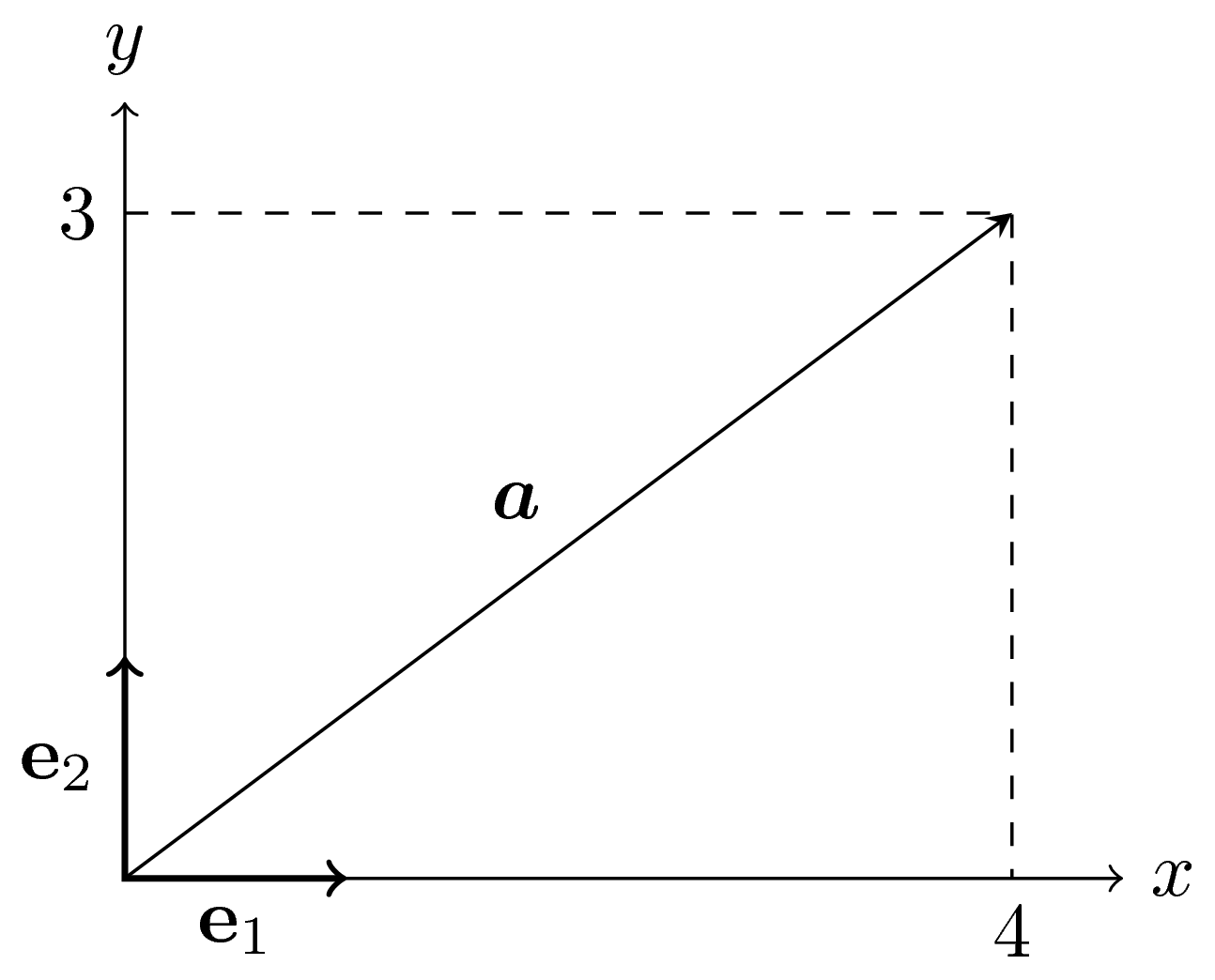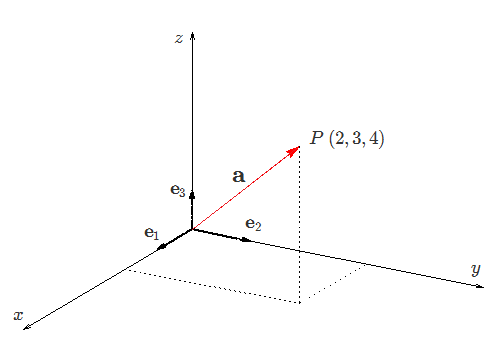Vectors in Cartesian Coordinates
Definition and Notation
A vector is a geometric object which has both magnitude (size) and direction.
Vectors are typically denoted in print as lowercase letters in boldface.
- Example: $\boldsymbol{\mathrm{a} }$.
In handwriting, a tilde, arrow or underline is used to denote a vector. The convention for handwritten notation varies with geography and subject area.
- Example: $\tilde{a}$, $\vec{a}$, $\underline{a}$, $\underset{^\sim}a$
Vectors can be described using Cartesian coordinates, giving the components of the vector along each of the axes.
- Example: $ \boldsymbol{\mathrm{a} }=(a_1,a_2,a_3) $.
$\boldsymbol{\mathrm{e} }_1=(1,0,0)$ is a vector of length 1 in the $x$ direction, $\boldsymbol{\mathrm{e} }_2=(0,1,0)$ is a vector of length 1 in the $y$ direction and $\boldsymbol{\mathrm{e} }_3=(0,0,1)$ is a vector of length 1 in the $z$ direction. The notations $\hat{\boldsymbol{\mathrm{e} } }_1,\hat{\boldsymbol{\mathrm{e} } }_2,\hat{\boldsymbol{\mathrm{e} } }_3$; $\boldsymbol{\mathrm{i} },\boldsymbol{\mathrm{j} },\boldsymbol{\mathrm{k} }$; and $\hat{\boldsymbol{\mathrm{x} } },\hat{\boldsymbol{\mathrm{y} } },\hat{\boldsymbol{\mathrm{z} } }$ are equivalent to $\boldsymbol{\mathrm{e}_1},\boldsymbol{\mathrm{e}_2},\boldsymbol{\mathrm{e}_3}$.
A vector can also be described as a sum of multiples of each of the unit basis vectors.
- Example: $\boldsymbol{\mathrm{a} }=a_1\boldsymbol{\mathrm{e} }_1+a_2\boldsymbol{\mathrm{e} }_2+a_3\boldsymbol{\mathrm{e} }_3$.
Example

|440px|center
A two-dimensional vector $\boldsymbol{\mathrm{a}}=(4,3)=4\boldsymbol{\mathrm e}_1+3\boldsymbol{\mathrm e}_2$.

| 500px | center
A three-dimensional vector $\boldsymbol{\mathrm{a}}$, beginning at the origin and ending at the point $P(2,3,4)$. The vector $\boldsymbol{\mathrm{a}}$ can be expressed in the following ways:
- $\boldsymbol{\mathrm{a}}=(2,3,4)$
- $\boldsymbol{\mathrm{a}}=2\boldsymbol{\mathrm e}_1+3\boldsymbol{\mathrm e}_2+4\boldsymbol{\mathrm e}_3$
Properties
Addition and Subtraction
Addition and subtraction in vectors works component-wise.
Given vectors $\boldsymbol{\mathrm{a} }=(a_1,a_2,a_3)$ and $\boldsymbol{\mathrm{b} }=(b_1,b_2,b_3)$ the following properties hold:
- $\displaystyle{ \boldsymbol{\mathrm{a} }+\boldsymbol{\mathrm{b} }=(a_1+b_1,a_2+b_2,a_3+b_3) } $
- $\displaystyle{ \boldsymbol{\mathrm{a} }-\boldsymbol{\mathrm{b} }=(a_1-b_1,a_2-b_2,a_3-b_3). } $
Or, equivalently:
- $\displaystyle{ \boldsymbol{\mathrm{a} }+\boldsymbol{\mathrm{b} }=(a_1+b_1){\boldsymbol{\mathrm{e} }_1}+(a_2+b_2){\boldsymbol{\mathrm{e} }_2}+(a_3+b_3){\boldsymbol{\mathrm{e} }_3} }$
- $\displaystyle{ \boldsymbol{\mathrm{a} }-\boldsymbol{\mathrm{b} }=(a_1-b_1){\boldsymbol{\mathrm{e} }_1}+(a_2-b_2){\boldsymbol{\mathrm{e} }_2}+(a_3-b_3){\boldsymbol{\mathrm{e} }_3}. }$
Scalar Multiplication
Given a vector $\boldsymbol{\mathrm{a} }=(a_1,a_2,a_3)$ and a scalar (real number) $\lambda$ the following property holds:
\[\displaystyle{ \lambda\boldsymbol{\mathrm{a} }=(\lambda a_1,\lambda a_2,\lambda a_3). }\]
Or, equivalently
\[\displaystyle{ \lambda\boldsymbol{\mathrm{a} }=\lambda a_1\boldsymbol{\mathrm{e} }_1 + \lambda a_2\boldsymbol{\mathrm{e} }_2 + \lambda a_3\boldsymbol{\mathrm{e} }_3. }\]
Properties of Scalar Multiplication
For any vectors $\boldsymbol{\mathrm{a} },\boldsymbol{\mathrm{b} }$ and scalars $\lambda,\mu$ the following properties hold:
- Distributivity
- $\lambda(\boldsymbol{\mathrm{a} }+\boldsymbol{\mathrm{b} })=\lambda\boldsymbol{\mathrm{a} } + \lambda\boldsymbol{\mathrm{b} }$
- $(\lambda+\mu)\boldsymbol{\mathrm{a} }=\lambda\boldsymbol{\mathrm{a} }+\mu\boldsymbol{\mathrm{a} }$
- Associativity
- $(\lambda\mu)\boldsymbol{\mathrm{a} }=\lambda(\mu\boldsymbol{\mathrm{a} })$
Length
The length of a vector $\boldsymbol{\mathrm{a} }=(a_1,a_2,a_3)$ is denoted $\lvert\boldsymbol{\mathrm{a} }\rvert$ or $\lVert \boldsymbol{\mathrm{a} }\rVert$ and can be calculated in the following way:
\[\lvert\boldsymbol{\mathrm{a} }\rvert=\sqrt{a_1^2+a_2^2+a_3^2}\]
The length of a vector is also referred to as its magnitude or norm.
Unit Vectors
A unit vector is a vector of length $1$. A “hat” is typically used to denote that a vector is a unit vector.
Example: A vector of length 1 in the direction of vector $\boldsymbol{\mathrm{a} }$ is denoted $\hat{\boldsymbol{\mathrm{a} } }$.
A non-zero vector $\boldsymbol{\mathrm{a} }$ can be scaled by the reciprocal of its length to obtain the unit vector $\hat{\boldsymbol{\mathrm{a} } }$. This process is known as normalising a vector.
\[\hat{\boldsymbol{\mathrm{a} } }=\cfrac{\boldsymbol{\mathrm{a} } }{\lvert\boldsymbol{\mathrm{a} }\rvert}=\left(\cfrac{a_1}{\lvert\boldsymbol{\mathrm{a} }\rvert},\cfrac{a_2}{\lvert\boldsymbol{\mathrm{a} }\rvert},\cfrac{a_3}{\lvert\boldsymbol{\mathrm{a} }\rvert}\right)\]
Worked Example
Example 1
Given vectors $\boldsymbol{\mathrm{a} }=\left(4,-3,9\right)$ and $\boldsymbol{\mathrm{b} }=(7,5,-2)$, find the unit vector in the direction of $\boldsymbol{\mathrm{a} }+\boldsymbol{\mathrm{b} }$.
Solution
By the properties of addition and subtraction, the $i$th component of $\boldsymbol{\mathrm{a} }+\boldsymbol{\mathrm{b} }$ is the sum of the $i$th component of $\boldsymbol{\mathrm{a} }$ and the $i$th component of $\boldsymbol{\mathrm{b} }$. For example, the first component of $\boldsymbol{\mathrm{a} }+\boldsymbol{\mathrm{b} }$ is $4+7=11$.
Thus, \begin{align} \boldsymbol{\mathrm{a} }+\boldsymbol{\mathrm{b} } &= \left(4+7,\,-3+5,\,9-2\right) \\ &=\left(11,\,2,\,7\right). \end{align}
Recall that the unit vector in the direction of a vector $\boldsymbol{\mathrm{x} }$ is given by
\[\hat{\boldsymbol{\mathrm{x} } }=\dfrac{\boldsymbol{\mathrm{x} } }{\lvert\boldsymbol{\mathrm{x} }\rvert}.\]
Therefore the length of the vector $\boldsymbol{\mathrm{a} }+\boldsymbol{\mathrm{b} }$ must be calculated:
\begin{align} \lvert\boldsymbol{\mathrm{a} }+\boldsymbol{\mathrm{b} }\rvert &= \sqrt{\strut{11^2+2^2+7^2} } \\ &=\sqrt{174}. \end{align}
It is generally preferred to leave this quantity in surd form, rather than calculate a decimal approximation.
Hence, the unit vector in the direction of $\boldsymbol{\mathrm{a} }+\boldsymbol{\mathrm{b} }$ is
\begin{align} \widehat{\boldsymbol{\mathrm{a} }+\boldsymbol{\mathrm{b} } } &= \dfrac{1}{\sqrt{174} }\left(11,2,7\right) \\ &= \left(\dfrac{11}{\sqrt{174} },\dfrac{2}{\sqrt{174} },\dfrac{7}{\sqrt{174} }\right). \end{align}
Or, equivalently,
\[\widehat{\boldsymbol{\mathrm{a} }+\boldsymbol{\mathrm{b} } }=\dfrac{11}{\sqrt{174} }\boldsymbol{\mathrm{e} }_1+\dfrac{2}{\sqrt{174} }\boldsymbol{\mathrm{e} }_2+\dfrac{7}{\sqrt{174} }\boldsymbol{\mathrm{e} }_3.\]
Workbooks
These workbooks produced by HELM are good revision aids, containing key points for revision and many worked examples.
See Also
External Resources
- Introduction to vectors workbook at mathcentre.
- Cartesian components of vectors workbook at mathcentre.
- Introduction to vectors videos at Khan Academy.